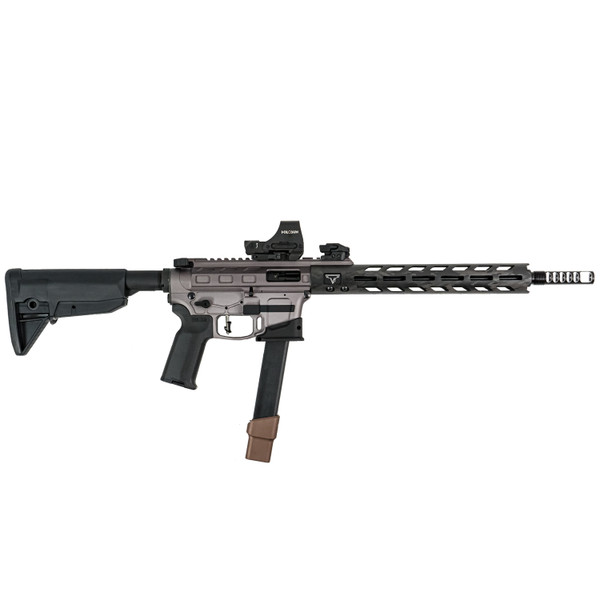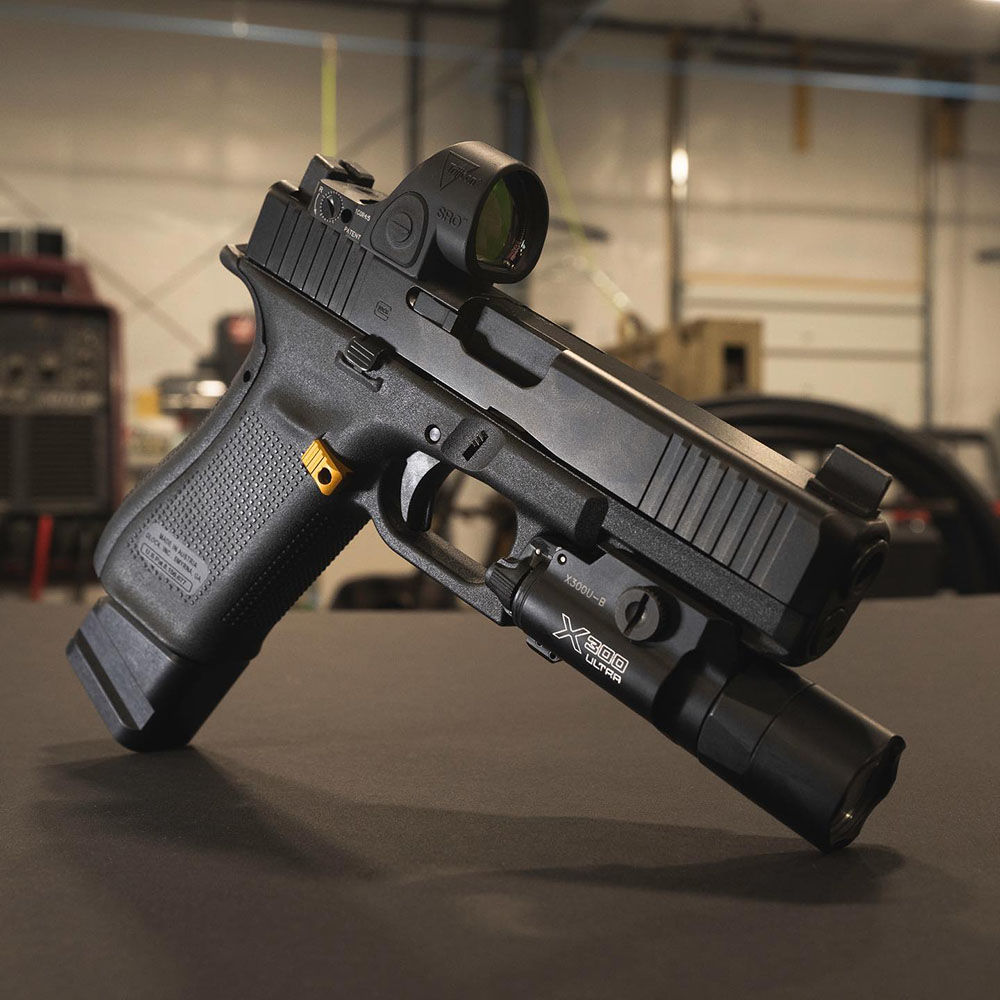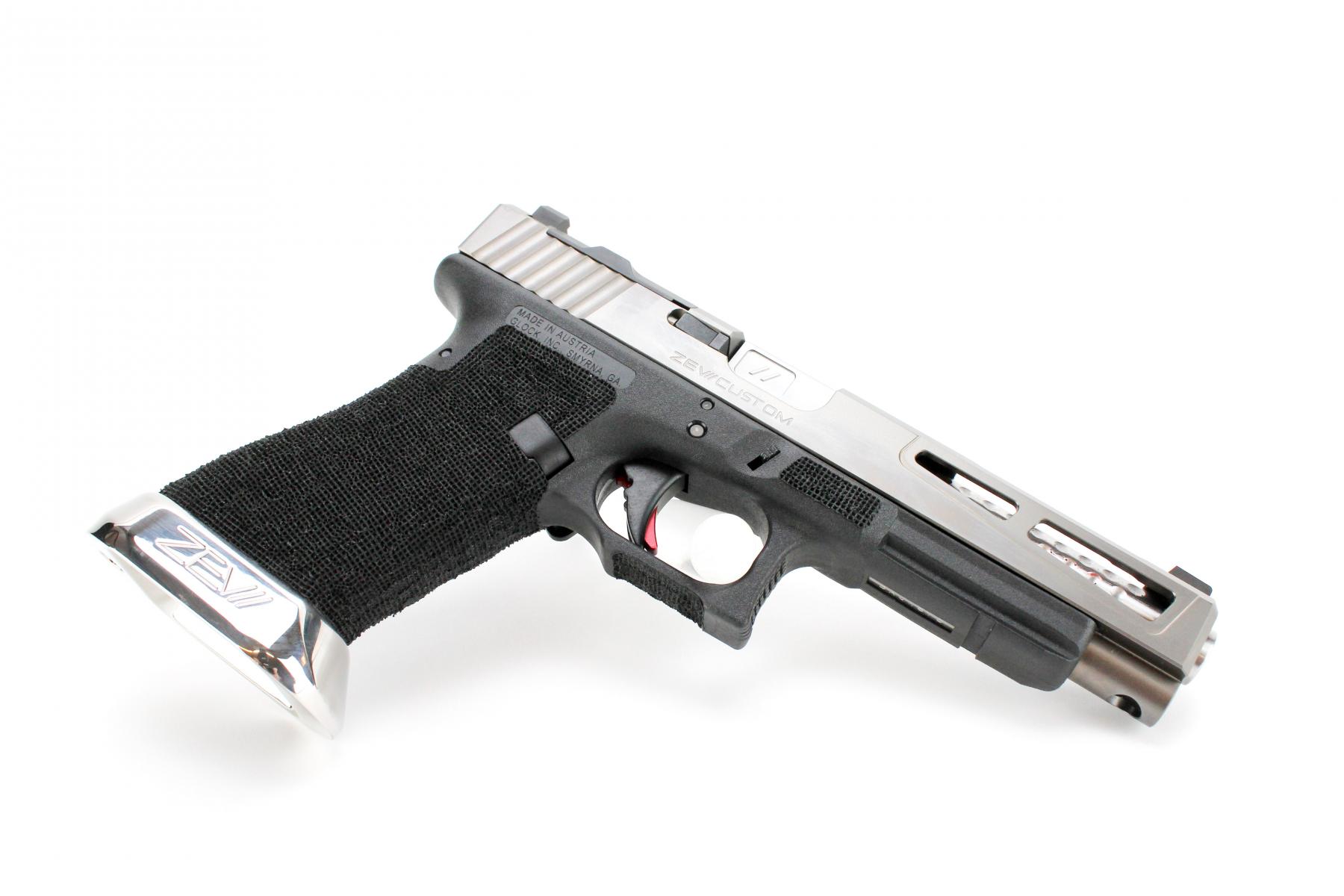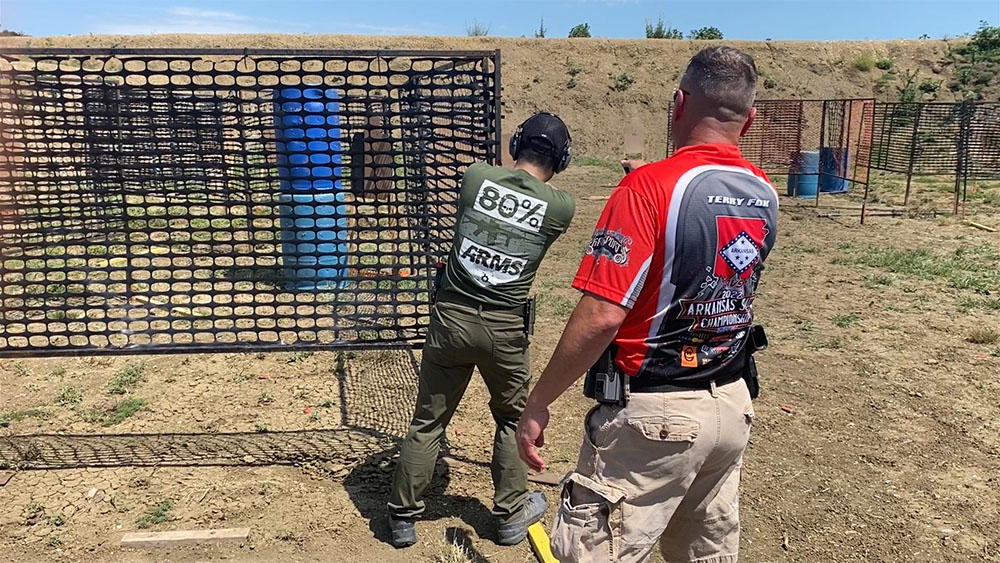Intro to IDPA for Beginners
Shooting competitions are an exciting way to test your skills and compete with others who share a passion for firearms. In the competition world, you will find various types of matches such as IDPA, USPSA, 3-Gun, and Steel Challenge among others. Each competition has a unique set of rules and challenges which makes it all the more fun. IDPA stands for"International Defensive Pistol Association" and it's a very specific type of beast to tame.
How to Sign up for IDPA
Photo Source: Practiscore
Before my first competition, I had to complete the registration online. There is one main source for where you sign up and can even track your past match results once you have a few under your belt.
Practiscore has made the entire competition process incredibly easy for everyone, with all matches, locations, information, and general rules under one roof. To sign up, I visited practiscore.com, created an account, searched for events in my area, and registered for the matches that interested me. IDPA's own website also has a match finder page so you can utilize that as well.
What to Prepare for IDPA
Here are the basics for what you need to prepare for IDPA matches. Please note that by your 3rd IDPA match you will be forced to become an IDPA member(otherwise you won't be allowed to participate even in local matches) which will allow you compete in sanctioned matches, rank you properly online, and connect you to more competitive shooters. The annual is fee is currently $50.
Universal Competition Utility
- A reliable firearm (pistol)
- Ammunition (In my most recent IDPA competition, I only shot about 60 rounds)
- Appropriate Holster (must be worn on the hip externally)
- Appropriate Magazine Carriers (prepare two because you can only carry a maximum of three mags in total)
- Appropriate belt (this is not the place to where your duty/warbelts)
- Hearing and eye protection
- Comfortable clothing and footwear
- A range bag to hold your gear
IDPA Unique Requirements
You'll commonly see competitors using a vest for concealment but technically you can use a jacket, hoodie, or even a simple flannel. The point is that many stages in IDPA matches require you to draw your pistol from "concealment."
Photo Source: Comp-Tac
IDPA Pistol Matches
IDPA shooting focuses on practical, real-world self-defense scenarios. Competitors use handguns and follow specific rules regarding equipment, concealment, and course of fire.
You'll encounter anywhere between 4 to 6 stages with different requirements per stage. For example, some may be loaded vs unloaded start. Other stages may have you start with a gun loaded or unloaded but resting and a table/barrel.
Even your mag capacity becomes a factor in certain stage requirements. So be prepared to be flexible and listen carefully for each stage's rules, otherwise known as the "course of fire."
How is IDPA Scored?
Photo Source: Gun Fun
Great question. IDPA rules use a scoring system called
time plus.
What that means is your accuracy is key in this competition. Sure you want to go fast too but notice the target to the left. It's not like in USPSA matches that utilize ABCD markings.
Your goal should be to hit the -0 areas of the target to the best of your ability. Best 2 shots on target are counted so say you had a third shot in a -1 area but two hits were within the -0 area. The -1 shot is then disregarded.
At the end of a stage let's say you took 20 seconds to clear the stage. The scoring doesn't stop there. If you had any targets that had hits in areas other than -0 your time will then increase based on how many hits landed in those "time plus" sections.
If you miss targets completely that's -5 seconds. So say you hit every target except for one that was completely missed. Paper targets require two hits so that would be a total of 10 second penalty. Your final stage score would be 30 seconds.
There are also procedural errors/penalties. Say that missed target was not engaged at all (meaning you didn't shoot it because you didn't see it or forgot) then you may incur an additional penalty under what's called a "failure to engage."
Lots to consider and remember right? Welcome to IDPA.
What are the IDPA divisions?
IDPA divisions are different from what they have in USPSA so it's important to know wha you're signing up for.
These are all divisions you have to choose from (be prepared for some acronyms):
SSP - Stock Service Pistol — Most beginners start here, which is perfectly fine and normal. Think of this division as "you just bought a gun and you take it to a competition straight out of its original packaging." That means virtually no modifications are allowed. The minimum caliber is 9mm and the mag capacity is 10 rounds plus 1 in the chamber. This Beretta M9 below is one example of an appropriate "SSP."

Photo Source: Rifle Gear
PCC - Pistol Caliber Carbine — Just like how it sounds, this is where all the AR-9 folks live. But you can also use other platforms such as a the Sig MPX, the HK MP5, Stribog SP9, or even Kalashnikov's KP9. There are a lot of fun options! It's a highly popular division that even has its own separate Nationals event. Its magazine capacity limit is 30 rounds. The AR-9 below from Taran Tactical Innovations is one example of a PCC.

Photo Source: TTI
CCP - Compact Carry Pistol — This is an older division that is meant to allow users to practice the use of pistols they'd actually carry on their person in everyday life. The size of the pistol matters and is referred to as "the box" that it has to fit in. The best example of a CCP would be the Glock 19. Mag limitation is 8+1 rounds which doesn't make sense but this division still exists anyways. 
Photo Source: Glock USA
CO - Carry Optics — Our favorite go-to division. You guessed it, this is where you can break out those red dot sights. Think of this as another ESP division except optics are allowed. With how popular the use of pistol optics are becoming these days, carry optics is one of the most widely used divisions in both IDPA and USPSA.

Photo Source: JagerWerks
DP - Custom Defensive Pistol — This division was literally built for 1911 users. However, the rules is that as long as you're shooting .45 ACP with a magazine capacity limitation of 8 rounds +1 in the chamber, you can use other pistol models as well.

Photo Source: Sportsman Outdoor
ESP - Enhanced Service Pistol — This is as race gun as it gets in IDPA. Here you can use external magwells, have aggressive stippling, there's no restriction on action type so you'll see all sorts of guns here but a good example would be a tricked out Glock 34. No optics though, so it's still iron sights only here.

Photo Source: Arzen Arms
BUG - Backup Gun — This is a rarely used division but there are those who do compete in it. BUG is specifically for very small guns like subcompact and microcompact pistols. Caliber wise, .380 ACP is the smallest allowed and the division ammo capacity is 5 rounds per magazine. +1 for the chamber if you're doing loaded starts. I might try running my tiny P365 in a match this year just for kicks.
Photo Source: Collectors Firearms
Revolver — Need we say more? You're probably a cowboy since you favor the wheel gun. Allowed calibers include .38 Special, .357 Magnum, .44 Magnum, 10mm, .45ACP, .40 S&W, essentially anything that can be loaded via moon clips.

Photo Source: Ruger
General Etiquette
Here are some general etiquette guidelines for shooting matches:
- Follow all safety rules diligently.
- Be respectful and courteous to fellow competitors and range staff.
- Help with tasks such as taping targets and resetting stages.
- Wait your turn and avoid interrupting other shooters.
- NEVER have ammunition in your firearm unless a Safety Officer has told you it's ok to do so.
Things That Would Disqualify You
Some actions that could lead to disqualification in a shooting match include:
- Unsafe gun handling i.e. flagging yourself or others
- Breaking the 180-degree rule (pointing your gun beyond the designated safe angles)
- Failing to follow range commands from Safety Officers
- Unsportsmanlike conduct
Types of Matches
In my local match, there were four courses. (You may encounter more at other matches) Each with unique challenges and shooting scenarios. Competitors can expect to navigate various stages, engaging targets from different positions and angles.
Local matches may be more lax in how many and what kind of rules are enforced. If you do go to the Majors, or a sanctioned match (whether it's at the state or national level) you can expect to see a lot of more rules being enforced with firearms and gear being closely inspected.
Course of Fire Tips
IDPA stages are very interesting (because there are a lot of rules to keep track of). You can expect to start by facing a wall, down range or even be up range. You may even have to run to pick up and load your firearm before engaging targets.
There will be different positions of which you are to specifically engage target clusters in a specific order. This is why coming as early to the match to study the course of fire is important and very helpful. But on the fly, how do you tell which direction to fire or which targets to engage first in a cluster?
You'll see barrier thresholds on the ground typically marked by pieces of wood. If you have to lean left and use your left foot to rest on the threshold in order to see the targets past a barrier, then you'll know you should engage those targets left to right. Similarly, if the threshold on the ground is on your right sight and you're leaning right past a barricade in order to see and engage a target cluster then you know you have to shoot those targets right to left.

Past this "wall" there were 2 targets, the correct order to engage them here would be right to left. Photo Source: 80 Percent Arms
Additionally, let's say there are two clusters of target that you are to engage from a single position. Always engage the closer target cluster first. Failing to do so would result in a procedural error. If any targets are "in the open" that then means you can engage them on the move and aren't necessarily locked into a position from where you must stay put and engage them from.
Some stages are strict even with when and where you are allowed to conduct your reloads. Remember, IDPA doesn't allow for a lot of rounds to be loaded in your mags so you'll have to count your shots and plan for reloads accordingly. When on the move during the stage, make sure to keep that muzzle down range or pointed in the safest possible direction.
Stage involving looking through various covers. Photo Source: 80 Percent Arms
What do you do after you finish a stage?
Observe other shooters and how they operate. Once you've completed a stage, all you have to do is listen to your SO's commands.
You'll hear them say something along the lines of, "if shooter is finished, show clear, hammer down, and holster your weapon." Until you're a recognized competitor don't rush through this. SO's can tell you when you're new so go slow on purpose so they can identify you are being safe.
What I'll do is go step by step. When I'm done with a stage, I'll drop my magazine, rack my slide back (ejecting a round), wait for the SO to say "I see clear), release the slide and pull the trigger.
Once the SO hears the trigger break I'll holster my pistol after being told to do so. It's pretty simple, but I've also seen a beginner get DQ'd for rushing through this and having a negligent discharge. Thankfully, his gun was pointed downrange when that happened. Morale of the story: don't try too hard to look cool.
Some Advice on How to Score Points Efficiently
- Take your time! As we've mentioned already, IDPA shooting skills and strategy will differ from your plan of attack compared to how you'd run a stage in say USPSA matches. Avoid rushing to reduce missed shots and penalties; focus on accuracy and smooth movements instead.
- Take pointers from the other competitors around you. They all want to help and see people get comfortable shooting in a higher intensity environment compared to a normal range day.
- Focus on where your finger and muzzle are constantly. That may seem like a no brainer but when running these courses You have a lot of stimuli and it takes more focus than you would expect to keep your firearm fundamentals up.
- The challenges and things to keep track of can compound especially if you're shooting outdoors under adverse weather conditions so don't forget to hydrate and bring snacks if you need them. Stay sharp and be safe.
Build your GST-9 and shoot in IDPA!
Honestly we didn't know what to expect when we showed up. One of us is 23 years old and another is 29 so we were by far the youngest and most inexperienced shooters in the squads. Despite that they gave us pointers rather than chastising us just because we were new.
They welcomed us with open arms and showed us the ropes. It was initially an intimidating experience, as your focus can easily go all over the place the first couple of times you go to a match. But now that we've been to a few, we're beginning to find our groove.
If you're ready to join us and put your skills to the test, get started and
build your GST-9 today!



 Back to List
Back to List